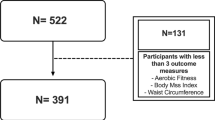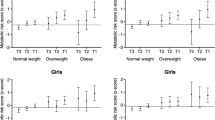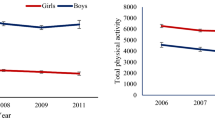Abstract
Aim:
The benefits of promoting physical activity (PA) in counteracting the high prevalence of childhood obesity have become increasingly important in the past decade. The aim of this study was to examine the association between compliance of daily PA recommendations and the risk of being overweight or obese in preschool-aged children.
Methods:
The sample comprised 607 children aged 4–6 years, recruited from kindergartens located in the metropolitan area of Porto, Portugal. Preschooler’s body mass index was classified according to International Obesity Task Force. PA was assessed during 7 consecutive days by accelerometer. Children were classified as meeting or not meeting PA recommendations based on two guidelines: (i) at least 3 h per day of total PA (TPA); and (ii) at least 1 h per day of moderate to vigorous PA (MVPA).
Results:
The prevalence of overweight and obesity was 23.5 and 10.6% in girls and 17.2 and 8.9% in boys. In all, 90.2 and 97.3% of girls met the ⩾1 h MVPA and ⩾3 h TPA recommendations, respectively. In all, 96.2 and 99.4% boys met the ⩾1 h MVPA and ⩾3 h TPA recommendations, respectively. Boys were significantly more likely to achieve the ⩾1 h MVPA and ⩾3 h TPA recommendations than girls (P⩽0.001). Not meeting the ⩾1 h MVPA guideline was associated with obesity status (OR: 3.8; IC: 1.3–10.4), in girls, but not boys. No other statistically significant associations were found.
Discussion:
These findings suggest that over 90% of children met the recommended guidelines. There is an association with low levels of MVPA and higher obesity status among preschool girls. Further, longitudinal studies are needed to confirm these data.
This is a preview of subscription content, access via your institution
Access options
Subscribe to this journal
Receive 12 print issues and online access
$259.00 per year
only $21.58 per issue
Buy this article
- Purchase on Springer Link
- Instant access to full article PDF
Prices may be subject to local taxes which are calculated during checkout

Similar content being viewed by others
References
WHO. Childhood overweight and obesity. Childhood overweight and obesity. In 2011.
Vale S, Santos R, Soares-Miranda L, Rêgo C, Moreira P, Mota J . Prevalence of overweight and obesity among Portuguese preschoolers. Archives of Exercise in Health and Disease 2011; 2: 65–68.
Sardinha LB, Santos R, Vale S, Silva AM, Ferreira JP, Raimundo AM et al. Prevalence of overweight and obesity among Portuguese youth: a study in a representative sample of 10-18-year-old children and adolescents. Int J Pediatr Obes 2011; 6: 124–128.
Bouchard C . The obesity epidemic: Introduction. In: Kinetics H (ed). Physical Activity and Obesity.. Champaign, IL, USA, 2000. pp 3–20.
Twisk JW, Kemper HC, van Mechelen W, Post GB . Tracking of risk factors for coronary heart disease over a 14-year period: a comparison between lifestyle and biologic risk factors with data from the Amsterdam Growth and Health Study. Am J Epidemiol 1997; 145: 888–898.
Schmidt GJ, Walkuski JJ, Stensel DJ . The Singapore Youth Coronary Risk and Physical Activity Study. Med Sci Sports Exerc 1998; 30: 105–113.
WHO. Global Strategy on Diet, Physical Activity and Health. In 2004.
Dietz WH . Overweight in childhood and adolescence. N Engl J Med 2004; 350: 855–857.
Guo SS, Wu W, Chumlea WC, Roche AF . Predicting overweight and obesity in adulthood from body mass index values in childhood and adolescence. Am J Clin Nutr 2002; 76: 653–658.
Departament of Health PA, Health Improvement and Protection. Start Active, Stay Active: a report on physical activity for health from the four home countries. Health Do (ed). London, UK, 2011.
Australian G Move and Play Every Day. National Physical Activity Recommendations for Children 0-5 Years. Ageing. Commonwealth of Australia: DoHa, 2010.
Tremblay MS, Leblanc AG, Carson V, Choquette L, Connor Gorber S, Dillman C et al. Canadian Physical Activity Guidelines for the Early Years (aged 0-4 years). Appl Physiol Nutr Metab 2012; 37: 345–356.
Reilly JJ, Armstrong J, Dorosty AR, Emmett PM, Ness A, Rogers I et al. Early life risk factors for obesity in childhood: cohort study. BMJ 2005; 330: 1357.
Trost SG, Sirard JR, Dowda M, Pfeiffer KA, Pate RR . Physical activity in overweight and nonoverweight preschool children. Int J Obes Relat Metab Disord 2003; 27: 834–839.
Janz KF, Levy SM, Burns TL, Torner JC, Willing MC, Warren JJ . Fatness, physical activity, and television viewing in children during the adiposity rebound period: the Iowa Bone Development Study. Preventive Medicine 2002; 35: 563–571.
Vale S, Santos R, Soares-Miranda L, Moreira C, Ruiz JR, Mota J . Objectively measured physical activity and body mass index in preschool children. International Journal of Pediatrics 2010; 2010, doi:10.1155/2010/479439.
Espana-Romero V, Mitchell JA, Dowda M, O'Neill JR, Pate RR . Objectively measured sedentary time, physical activity and markers of body fat in preschool children. Pediatr Exerc Sci 2013; 25: 154–163.
Cole T, Bellizzi M, Flegal K, Dietz W . Establishing a standard definition for child overweight and obesity worldwide: international survey. Bmj 2000; 320: 1240–1243.
Janz KF . Validation of the CSA accelerometer for assessing children's physical activity. Med Sci Sports Exerc 1994; 26: 369–375.
Sardinha LB, Baptista F, Ekelund U . Objectively measured physical activity and bone strength in 9-year-old boys and girls. Pediatrics 2008; 122: e728–e736.
Purslow LR, Hill C, Saxton J, Corder K, Wardle J . Differences in physical activity and sedentary time in relation to weight in 8-9 year old children. Int J Behav Nutr Phys Act 2008; 5: 67.
Evenson KR, Catellier DJ, Gill K, Ondrak KS, McMurray RG . Calibration of two objective measures of physical activity for children. J Sports Sci 2008; 26: 1557–1565.
Trost SG, Loprinzi PD, Moore R, Pfeiffer KA . Comparison of accelerometer cut points for predicting activity intensity in youth. Med Sci Sports Exerc 2011; 43: 1360–1368.
Pate RR, Almeida MJ, McIver KL, Pfeiffer KA, Dowda M . Validation and calibration of an accelerometer in preschool children. Obesity (Silver Spring) 2006; 14: 2000–2006.
Vale S, Santos R, Miranda L, Silva P, Mota J . Preschool children physical activity measurement: importance of epoch length choice. Pediatr Exerc Sci 2009; 21: 413–420.
Tur JA, Serra-Majem L, Romaguera D, Pons A . Profile of overweight and obese people in a Mediterranean region. Obes Res 2005; 13: 527–536.
Ball K, Crawford D . Socio-economic factors in obesity: a case of slim chance in a fat world? Asia Pac J Clin Nutr 2006; 15, (Suppl): 15–20.
Mota J, Silva G . Adolescents` physical activity with socio-economic status and parental participation among a Portuguese sample. Sport, education and Society 1999; 4: 193–199.
Vale S, Ricardo N, Soares-Miranda L, Santos R, Moreira C, Mota J . Parental Education and Physical Activity in Pre-School Children. Child: Care, Health and Development doi:10.1111/cch.12041.
Jago R, Baranowski T, Baranowski JC, Thompson D, Greaves KA . BMI from 3-6 y of age is predicted by TV viewing and physical activity, not diet. Int J Obes (Lond) 2005; 29: 557–564.
Metallinos-Katsaras ES, Freedson PS, Fulton JE, Sherry B . The association between an objective measure of physical activity and weight status in preschoolers. Obesity (Silver Spring) 2007; 15: 686–694.
Moore LL, Gao D, Bradlee ML, Cupples LA, Sundarajan-Ramamurti A, Proctor MH et al. Does early physical activity predict body fat change throughout childhood? Preventive Medicine 2003; 37: 10–17.
Janz KF, Burns TL, Levy SM . Tracking of activity and sedentary behaviors in childhood: the Iowa Bone Development Study. American journal of preventive medicine 2005; 29: 171–178.
Jimenez-Pavon D, Kelly J, Reilly JJ . Associations between objectively measured habitual physical activity and adiposity in children and adolescents: Systematic review. International Journal of Pediatric Obesity 2010; 5: 3–18.
Addo OY, Himes JH . Reference curves for triceps and subscapular skinfold thicknesses in US children and adolescents. Am J Clin Nutr 2010; 91: 635–642.
Acknowledgements
We thank the children, their parents, as well as the staff from the all kindergartens. This study was supported in part by grants: Portuguese Foundation for Science and Technology—SFRH/BPD/81566/2011, PTDC/DES/098309/2008, PEst-OE/SAU/UI0617/2011 and Spanish Ministry of Science and Innovation—RYC-2010-05957.
Author information
Authors and Affiliations
Corresponding author
Ethics declarations
Competing interests
The authors declare no conflict of interest.
Rights and permissions
About this article
Cite this article
Vale, S., Trost, S., Ruiz, J. et al. Physical activity guidelines and preschooler's obesity status. Int J Obes 37, 1352–1355 (2013). https://doi.org/10.1038/ijo.2013.109
Received:
Revised:
Accepted:
Published:
Issue Date:
DOI: https://doi.org/10.1038/ijo.2013.109
Keywords
This article is cited by
-
Weight status and meeting the physical activity, sleep, and screen-time guidelines among Texas children: results from a population based, cross-sectional analysis
BMC Pediatrics (2022)
-
Mothers’ and fathers’ media parenting practices associated with young children’s screen-time: a cross-sectional study
BMC Obesity (2018)
-
Comparison of accelerometer measured levels of physical activity and sedentary time between obese and non-obese children and adolescents: a systematic review
BMC Pediatrics (2018)
-
Impact of scheduling multiple outdoor free-play periods in childcare on child moderate-to-vigorous physical activity: a cluster randomised trial
International Journal of Behavioral Nutrition and Physical Activity (2018)
-
A randomised controlled trial of multiple periods of outdoor free-play to increase moderate-to-vigorous physical activity among 3 to 6 year old children attending childcare: study protocol
BMC Public Health (2016)



